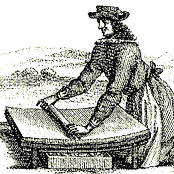![]()
|
|

|
| Europeans continued for centuries to use the Mesoamerican technique of grinding cacao beans on a "metate." | |
When the Spanish first brought chocolate back to Europe, it was still being served as a beverage, but soon went through an important evolution: the chili pepper was replaced by sugar. The new, sweetened, chocolate beverage was a luxury few could afford, but by the 17th century the drink was common among European nobility. In England, which was somewhat more egalitarian than the rest of Europe, chocolate was more widely available. Those who could afford it could enjoy chocolate drinks in the new coffee and chocolate houses of London.
As other countries challenged Spain's monopoly on cacao, chocolate became more widely available. Soon the French, English, and Dutch were cultivating cacao in their colonies in the Caribbean, and later, elsewhere in the world. With more production came lower prices, and soon the masses in Europe and the Americas were enjoying chocolate. For many people, however, the expanded production of cacao in the New World (along with that of other agricultural products) meant slavery and privation. Cacao production relied heavily on the forced labor of Native Americans and imported African slaves.
![]()
As cacao became more
commonly available, people began experimenting with new ways of using
it. Chocolate began to appear in cakes, pastries, and sorbets. But it
wasn't until 1828 that the "modern era" of chocolate making and production
began.
In 1828, Dutch chocolate maker Conrad J. van Houten patented an inexpensive method for pressing the fat from roasted cacao beans. The center of the bean, known as the "nib," contains an average of 54 percent cocoa butter, which is a natural fat. Van Houten's machine -- a hydraulic press -- reduced the cocoa butter content by nearly half. This created a "cake" that could be pulverized into a fine powder known as "cocoa." Van Houten treated the powder with alkaline salts (potassium or sodium carbonates) so that the powder would mix more easily with water. Today, this process is known as "Dutching." The final product, Dutch chocolate, has a dark color and a mild taste.
The introduction of cocoa powder not only made creating chocolate drinks much easier, but also made it possible to combine chocolate with sugar and then remix it with cocoa butter to create a solid. Others began to build on Van Houten's success, experimenting to make new chocolate products. In 1849, English chocolate maker Joseph Storrs Fry produced what was arguably the world's first eating chocolate.
Today, the Swiss are famous for their chocolate, and rightly so. In the late 19th century, they developed a number of processes that contributed greatly to creating the solid chocolate candy that we all enjoy today. Two major developments occurred in 1879. First, Daniel Peter, a Swiss chocolate manufacturer, had the idea of using powdered milk (invented by Swiss Chemist Henri Nestle in 1867) to make a new kind of chocolate, milk chocolate. Second, Rudolphe Lindt invented a process called "conching," which greatly improved the quality of chocolate candy by making it more blendable.
|
|